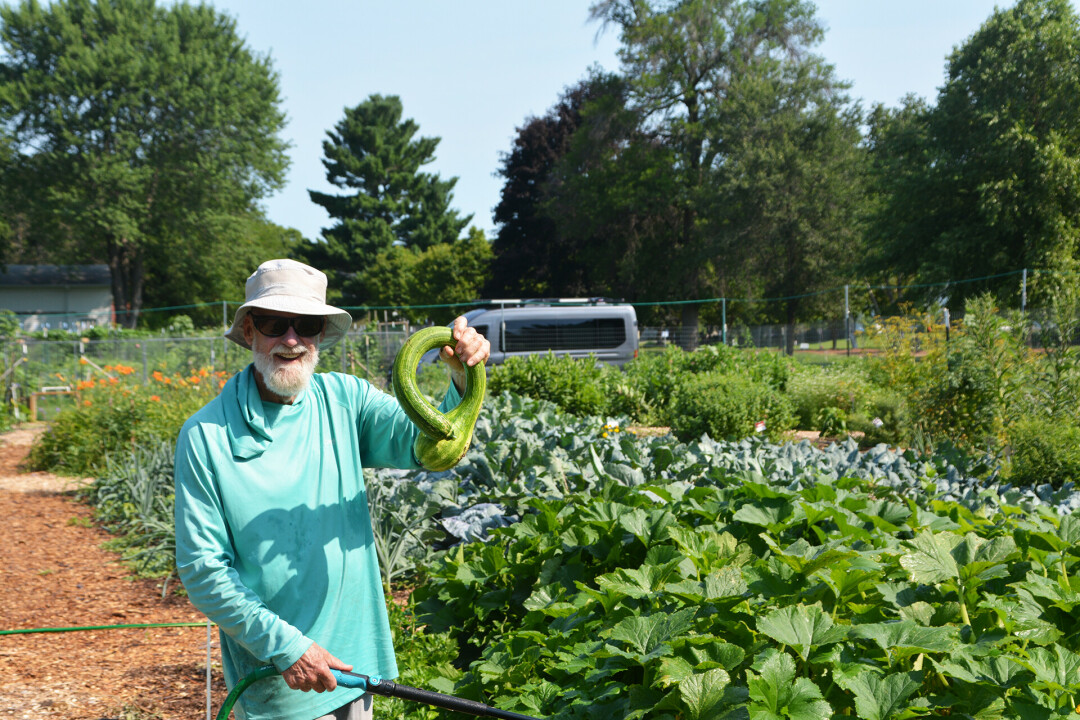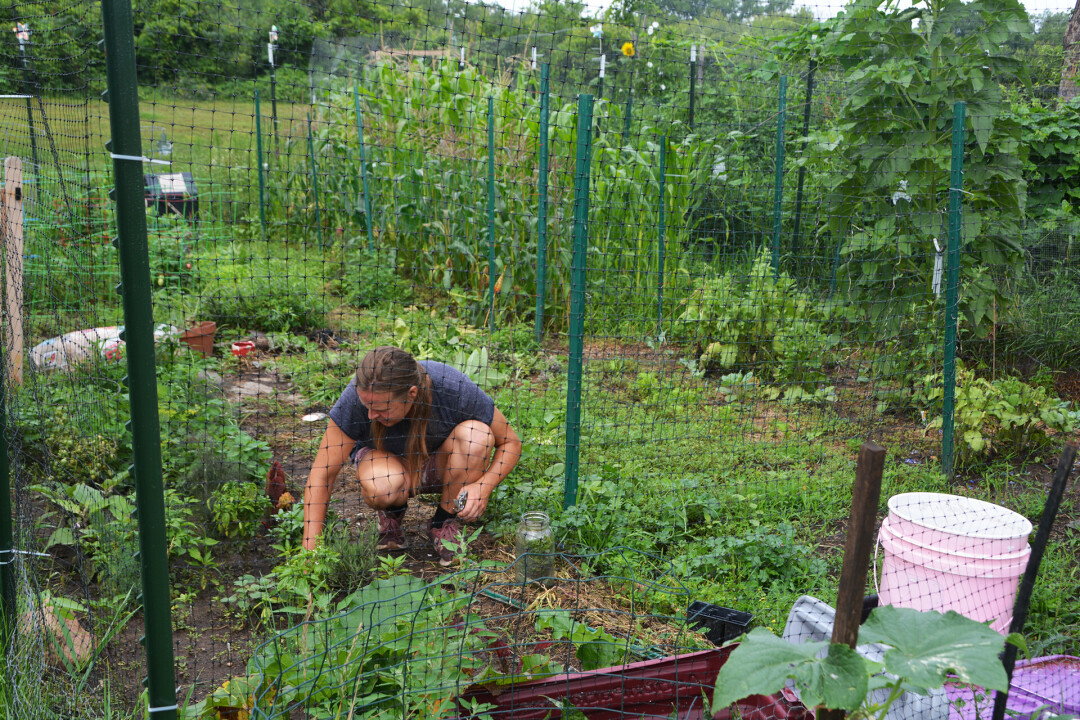
DIG IN. The bounty of Eau Claire’s community gardens is note solely in its produce, but in its ability to foster personal connections.
Looking for a resource that combines affordable food, community, and skill-building? From personal plots to shared gardens, the Chippewa Valley’s community gardens allow citizens to connect with nature by growing their very own produce in the heart of the city.
There are currently eight community gardens in the Valley. Altoona, Chippewa Falls, and Menomonie each have a designated garden, while five are located in various wards of Eau Claire.
Ruth Powers, a resident of Eau Claire, said she has been gardening at the Demmler Community Garden (524 Putnam Dr., Eau Claire) for several years. In her 15-by-20 plot, she grows an assortment of veggies, herbs, and flowers — from pumpkins and tomatoes to sunflowers and arugula.
Powers observed the synergistic relationship that developed between herself and fellow gardeners. She referenced the master gardeners at Demmler — like Judy and Jill — who have passed along knowledge to their community.
“Jill has been super generous with her seedlings and has given me great advice about things like growing garlic,” Ruth said. “It’s so nice to have these, and kind of a network to grow and support each other.”
While the gardeners at Demmler keep up their personal plots on their own time, Ruth mentioned that the garden has scheduled “work days.” On these days, members of the garden work as a cooperative to perform routine maintenance such as fence repair and laying down wood chips.
”
I FIND A LOT OF JOY IN GARDENING AND WATCHING THINGS GROW. EVEN IF I’M NOT SUPER GREAT AT IT, I LOVE BEING ABLE TO GO OUT THERE
and connect with nature and the things that I’m nurturing. It just reminds me that I need to keep doing the same things with myself and my other passions.
RUTH POWERS
EAU CLAIRE RESIDENT, DEMMLER COMMUNITY GARDEN MEMBER

Eau Claire has five community gardens, with several more found throughout the Chippewa Valley.
“As a community resource, I think it’s a really nice thing to have,” Ruth said. “It brings people together with a similar passion while letting each person create their own little garden.”
Tami Schraufnagel, a member of the Forest Street Neighborhood Association, has been managing Eau Claire’s Forest Street Gardens (534 Forest St., Eau Claire) for many years. According to Tami, this location contains a shared herb garden, a community plot garden, and a shared vegetable garden.
As both Ruth and Tami described, most of the community gardens in the area have supplies available, including wheelbarrows, gardening tools, and hoses. “When I first started out, I didn’t have all the tools I needed,” Ruth remarked. “To have everything available at the garden was so convenient.”
Tami recalled when current City Council Vice President Andrew Werthmann helped found the Forest Street gardens over a decade ago, after the city purchased the flood-prone land from former residents.
Due to a lack of nearby grocery stores, Werthmann had suggested the garden would serve as a valuable resource for those without access to fresh food.
“We worked with Andrew and a small committee of neighborhood folks and other volunteers to establish a garden here,” Tami explained.
After three years under city governance, the garden was turned over to be run completely by volunteers.
From the start, Tami said the garden has been donating excess produce to local food pantries and The Community Table. Additionally, she and her husband regularly transport leftover compost from the gardens to the city brush site (5710 Jeffers Rd., Eau Claire), where it is then combined with the city’s larger stockpile.
I think (the garden) is so valuable – it’s not only about food. It’s about giving back to (the) community and building our own here. It’s a great way for people to get to know each other and share knowledge and share food and camaraderie.
MARI JACKSON
MASTER GARDENER

The Forest Street garden is home to vegetable varieties like squash, peppers, corn, tomatoes, and beans, as well as herbs.

Mari Jackson is a master gardener who has been gardening for over 50 years. She is a former co-leader and member of the Forest Street Garden, where residents work as a cooperative to plant, tend to, and harvest communal crops.
This year, the shared garden is home to dozens of vegetable varieties like squash, peppers, corn, tomatoes, and beans, as well as a small herb garden.
In addition to regular volunteer hours, members pay an annual fee of $40-$55 to be part of the shared garden. Mari said decisions are made democratically within the group, with select members chosen as co-leaders.
“We actually developed a whole kind of a different way of organizing over a couple of years,” Mari said. “My co-leader suggested we do teams, so now that’s how we divide up work.”

According to Mari, each team has a designated task such as watering, knowledge, donations, harvesting, maintenance, and project management. The group holds consistent work days and monthly potluck meetings, where they share recipes and discuss garden projects. Mari said the collective project has resulted in a tightly-woven community among the gardeners.
“I think (the garden) is so valuable — it’s not only about food,” Mari said. “It’s about giving back to (the) community and building our own here. It’s a great way for people to get to know each other and share knowledge and share food and camaraderie.”
As Mari noted, the people who use shared and community gardens range broadly in age and background. She mentioned one Forest Street plot is tended by a group of unsheltered people who grow and share the food.
Ruth agrees with this sentiment, and commented on the personal value being part of a community garden can hold.
“I find a lot of joy in gardening and watching things grow,” Ruth said. “Even if I’m not super great at it, I love being able to go out there and connect with nature and the things that I’m nurturing. It just reminds me that I need to keep doing the same things with myself and my other passions.”
To learn more about community gardens in the Chippewa Valley, visit the Eau Claire Community Gardens website online, or check out Volume One’s listings on area community gardens.


Comments are closed.